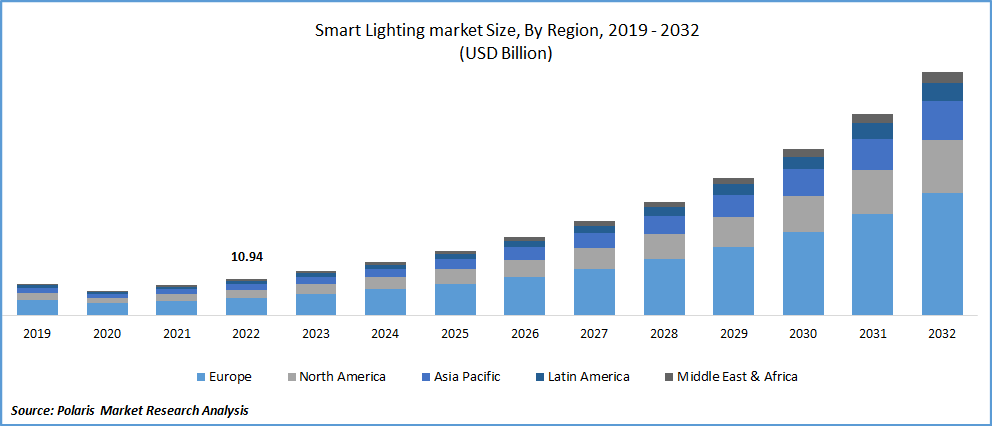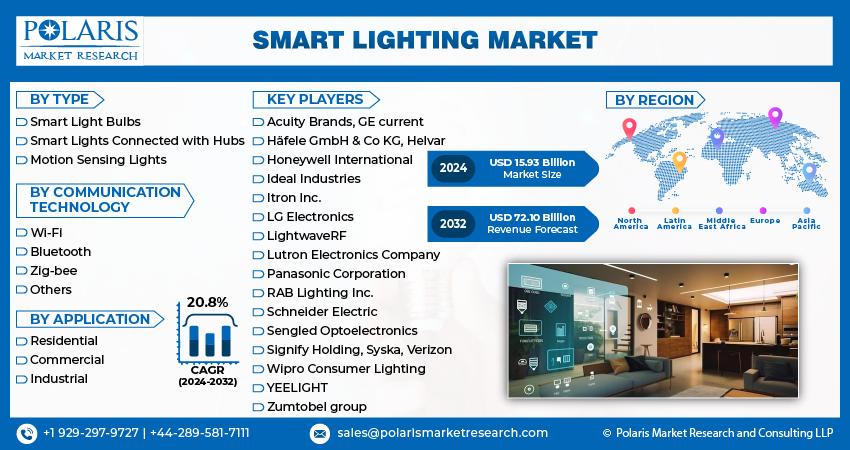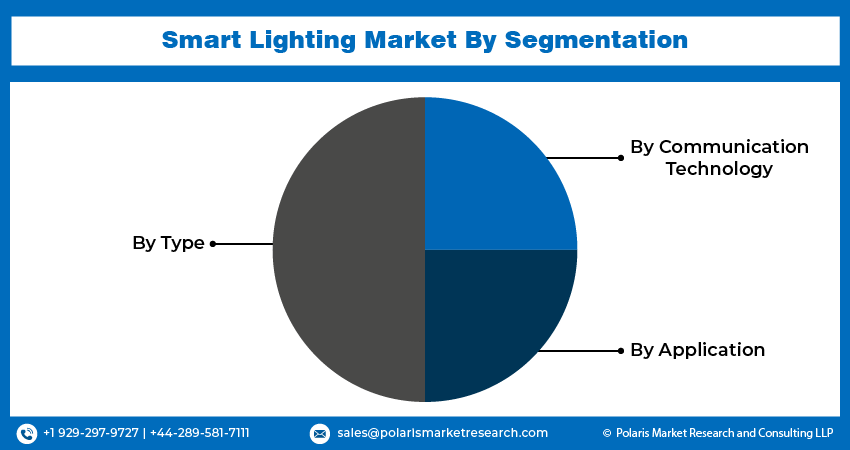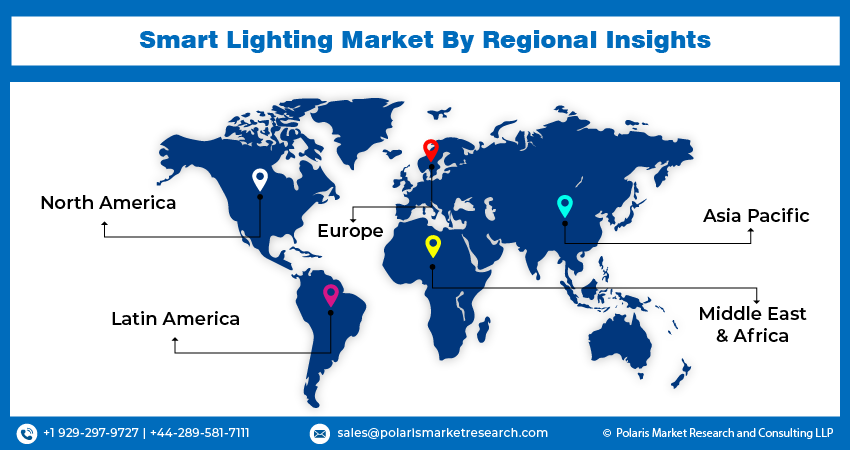
Smart Lighting Market Share, Size, Trends, Industry Analysis Report
By Type (Smart Light Bulbs, Smart Lights Connected with Hubs and Motion Sensing Lights); By Communication Technology; By Application; By Region; Segment Forecast, 2024 - 2032
- Published Date:Jan-2024
- Pages: 116
- Format: PDF
- Report ID: PM1996
- Base Year: 2023
- Historical Data: 2019-2022
Report Outlook
The global smart lighting market was valued at USD 13.2 billion in 2023 and is expected to grow at a CAGR of 20.8% during the forecast period. The quick expansion of smart city initiatives in established and emerging countries and the rising use of government subsidies for LED technology and sophisticated lighting systems drives the market for smart lighting.

Know more about this report: Request for sample pages
The need for intelligent lighting will further fuel the rapid expansion of commercial and industrial infrastructure developments. The growth of the smart lighting market during the anticipated period is also supported by an increase in end-use categories and growing government spending. The need for intelligent lighting has been significantly impacted negatively by the current COVID-19 outbreak. Due to the pandemic, there has been a modest decline in the demand for smart city engineering and construction services, which has led to a reduction in the usage of smart lighting systems.
Due to the ongoing COVID-19 pandemic's impact on production and raw material availability, other intelligent lighting firms have also reported declining sales. The pandemic also contributed to the fall in consumer purchasing power and the delay in finishing building projects, which reduced the quantity, schedule, and payment for purchase orders for smart lighting. As a result, it could limit the recent expansion of the worldwide market.

Know more about this report: Request for sample pages
Industry Dynamics
Growth Drivers
Government initiatives supporting energy efficiency, environmental protection, and strict laws against using incandescent bulbs are anticipated to be major drivers of the worldwide market for smart lighting. Around 19% of the world's power is generally used by the lighting industry, producing roughly 6% of greenhouse gas emissions.
The improved acceptance of standard protocols for intelligent lighting systems and new features such as API event generation and data analytics drive the market. Moreover, the United States, the United Kingdom, Germany, China, India, and Brazil are among the few key countries wherein smart cities have been expanding at an unprecedented rate.
According to the Consumer Technology Association, the sending on smart city projects globally reached almost USD 35.35 billion in 2020 from USD 14.85 billion in 2015. Similarly, the U.S. Government launched the “Smart Cities” initiative in 2015, with an investment of USD 160 million in the federal & incorporated more than 25 new technology collaborations to cope with challenges faced by local communities. Therefore, smart lighting has observed a significant rise in projects related to smart cities to improve the quality of life of individuals in the region.
Report Segmentation
The market is primarily segmented based on type, communication technology, application, and region.
|
By Type |
By Communication Technology |
By Application |
By Region |
|
|
|
|
Know more about this report: Request for sample pages
Motion-Sensing Lights Segment is Expected to Witness Considerable Cagr over the Forecast Period
The motion-sensing lights segment is expected to witness considerable CAGR in the global industry during the foreseen period. This is due to the extensive adoption of intelligent home infrastructure projects. It provides end users a higher degree of protection and lowers energy usage by automatically shutting off lights when no motion is detected.
Wi-Fi Segment is Expected to Hold the Most Significant Market in 2022
The Wi-Fi segment is expected to hold the most significant market capture in the global market during the foreseen period based on the communication technology segment. The residential sector is the major adopter of such technology to control luminaire hues within a confined space, which eventually led to a rise in segmental growth worldwide.
On the contrary, the Bluetooth segment is expected to register a considerable share in revenue in the global market. One of the key advantages of using Bluetooth mesh for intelligent lighting is that it can help two-way communications. A similar mesh infrastructure can commission smart lighting solutions and control luminaire performance.
Further, the Bluetooth mesh has continually proven to be the most efficient and easy-to-use wireless technology for professional lighting applications and the only extremely scalable wireless standard. For instance, as of December 2019, nearly 500 Bluetooth mesh-certified products are available, up to 90% of which are lighting-focused end products. Therefore, this factor will be key for driving market growth worldwide.

Residential Segment is Anticipated to Witness a Large Revenue in 2022
The residential segment is expected to see a large revenue size in the global market, owing to the extensive implementation of intelligent lighting in residential buildings because of the rise in consumer awareness regarding smart lighting and the performance of energy-efficient products.
On the other hand, the commercial sector is anticipated to grow at a considerable CAGR in the worldwide market throughout the forecast period. The lighting for the gardens, outside walls, terrace, and outdoor areas of the shop space is part of the commercial architectural application. The need to provide energy-efficient lighting and track outdoor activities drives the market demand for smart lighting in commercial applications. This phenomenon is only used with intelligent street lighting. The need for intelligent lighting in commercial spaces is expected to increase, which is expected to contribute considerably to the segment's quick expansion throughout the forecasted period.
Europe Estimated for the Largest Market Share in 2022
Europe will be leading the global market in 2022. It is estimated for the largest share in terms of revenue due to the regional government drafting safety and uniform performance standards for specific indoor commercial intelligent lighting for roadways, parking, and garages. Dedicated LED luminaires and brilliant alternative lamps are evolving as the key trend in the lighting industry concerning the continual developments in LED design and technology.
Moreover, Asia-Pacific observed a high CAGR in the global market in 2022. The demand for intelligent lighting in the region is attributed to an increase over the forecast period, backed by the growing number of smart city and smart infrastructure projects commenced by the governments and the favorable public-private initiatives for offering low-cost LED lights at reasonable prices across the region. For instance, the National Smart Cities Mission was introduced to develop the country’s cities into intelligent cities. It was also directed toward the transformation of 100 smart cities in India to be completed.

Competitive Insight
Some of the major players operating in the global market include Acuity Brands, GE current, Häfele GmbH & Co KG, Helvar, Honeywell International, Ideal Industries, Itron Inc., LG Electronics, LightwaveRF, Lutron Electronics Company, Panasonic Corporation, RAB Lighting Inc., Schneider Electric, Sengled Optoelectronics, Signify Holding, Syska, Verizon, Wipro Consumer Lighting, YEELIGHT, and Zumtobel group ag.
Recent Developments
- In July 2022, Signify launched a new range of intelligent WiZ lighting solutions presented by the lighting industry pioneer to give fans of smart lighting more everyday comfort and efficiency.
- In March 2022, Wipro Lighting introduced Aqua, a chic line of custom office space lighting solutions, to enliven work areas. Diverse curved luminaires from Aqua can be used to convey an architect's design purpose.
Smart Lighting Market Report Scope
|
Report Attributes |
Details |
|
Market size value in 2024 |
USD 15.93 billion |
|
Revenue forecast in 2032 |
USD 72.10 billion |
|
CAGR |
20.8% from 2024 – 2032 |
|
Base year |
2023 |
|
Historical data |
2019 – 2022 |
|
Forecast period |
2024 – 2032 |
|
Quantitative units |
Revenue in USD billion and CAGR from 2024 to 2032 |
|
Segments Covered |
By Type, By Communication Technology, By Application, By Region |
|
Regional scope |
North America, Europe, Asia Pacific, Latin America, Middle East & Africa |
|
Key Companies |
Acuity Brands, GE current, Häfele GmbH & Co KG, Helvar, Honeywell International, Ideal Industries, Itron Inc., LG Electronics, LightwaveRF, Lutron Electronics Company, Panasonic Corporation, RAB Lighting Inc., Schneider Electric, Sengled Optoelectronics, Signify Holding, Syska, Verizon, Wipro Consumer Lighting, YEELIGHT, and Zumtobel group ag. |
FAQ's
Key companies in the smart lighting market are Acuity Brands, GE current, Häfele GmbH & Co KG, Helvar, Honeywell International, Ideal Industries, Itron Inc., LG Electronics, LightwaveRF, Lutron Electronics Company.
The global smart lighting market expected to grow at a CAGR of 20.8% during the forecast period.
Thesmart lighting market report covering key segments are type, communication technology, application, and region.
Key driving factor in the smart lighting market are government subsidies for LED technology and sophisticated lighting systems.
The global smart lighting market size is expected to reach USD 72.10 million by 2032.
